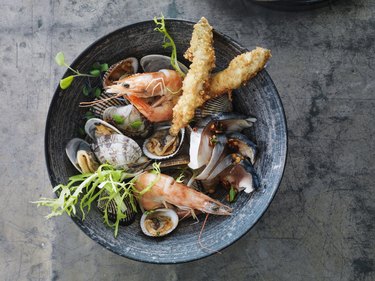
Currently, it is difficult to find breakfast cereal without folic acid. Folic acid is also known as folate, which is the natural form of vitamin B9 — a water-soluble vitamin naturally found in foods. Folic acid is the supplemental form, and has been added to food since 1998.
The decision to fortify cereals and bread products with folic acid was made in order to help prevent neural tube defects. Harvard Health explains that folic acid is 85 percent more absorbable than the folate found in foods. The Centers for Disease Control asserts that folic acid fortification in cereal grain products has helped to prevent 1,300 cases of neural tube defects per year.
Video of the Day
Video of the Day
Why Avoid Folic Acid?
Some people seek out foods without folic acid because of a recent concern with folic acid intake being linked to autism spectrum disorder. A November 2017 review in Brain Sciences discussed this issue. There are studies that show a decreased risk of autism spectrum disorder as a result of folic acid supplementation, while others show impeded neurocognitive development in the children of mothers who consumed dietary folic acid from fortified foods and had unmetabolized folic acid in their blood.
The 2017 review concludes that while supplementing with the recommended daily allowance (RDA) is very beneficial for preventing neural tube defects and even in the prevention of autism spectrum disorder, consuming more folic acid than the RDA may possibly contribute to the prevalence of the disorder. The study authors recommend further research be conducted.
The CDC explains that people who consume folic acid from fortified foods and vitamin supplements or a combination can have unmetabolized folic acid in their blood. However, they also maintain that unmetabolized folic acid does not cause any health problems.
Read More: 9 Foods to Eat Now if You Want to Get Pregnant
Folic Acid Food List
If you are concerned with the amount of folic acid you are consuming ,there are many foods that do not contain the supplemental form. The risks for autism spectrum disorder are not seen with folate found naturally in foods. Folic acid is added to cereal grain foods, such as breakfast cereal and bread products.
Seafood, meat, pork, poultry, candy and sweets are all free of folic acid. Most gluten-free grain products do not contain fortified folic acid, says a May, 2019 article in Current Developments in Nutrition. So if you desire breakfast cereal without folic acid, or bread without folic acid, gluten-free products may provide you with this option.
Overwhelming scientific evidence, as well as the CDC, Harvard Health and other health authorities, concur that getting the recommended daily allowance of vitamin B9 during pregnancy is critical for preventing neural tube defects such as spina bifida and anencephaly in infants. The CDC recommends 400 micrograms of folic acid every day. If you would prefer to obtain your folate from food sources, there are many available.
Read More: Side Effects of Folic Acid Tablets
Some foods naturally high in folate are edamame (482 micrograms per cup), arrowroot (405 micrograms per cup), roman beans (366 micrograms per cup), lentils (358 micrograms per cup), black-eyed peas (355 micrograms per cup), lamb liver (340 micrograms in 3 ounces), mung beans (221 micrograms per cup), pinto beans (294 micrograms per cup) and chickpeas (282 micrograms per cup).
Warning
If you are concerned with folic acid intake or supplementation, consult with your doctor.
- Harvard Health: "Folate (Folic Acid) – Vitamin B9"
- Centers for Disease Control and Prevention: "Key Findings: Folic acid fortification continues to prevent neural tube defect"
- Brain Sciences: "Is High Folic Acid Intake a Risk Factor for Autism?—A Review"
- Centers for Disease Control and Prevention: "General Information About NTDs, Folic Acid, and Folate"
- My Food Data: "200 Foods Highest in Folate (B9)"